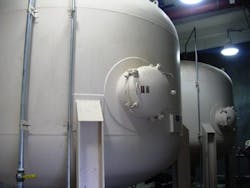Arsenic Treatment System in Moapa Valley, Nev., Performs ‘Flawlessly’
In the Mojave Desert 50 miles northeast of Las Vegas is a fertile stretch of land called the Moapa Valley. Its lush marshes have attracted new residents to the nearby towns of Moapa, Overton, Logandale and Warm Springs—a spillover from Las Vegas’ dynamic growth in recent years.
Water is a major element in the history of any settlement in the Desert Southwest, and the local water authority—Moapa Valley Water District (MVWD)—and its predecessors have wisely planned for the region’s present and future water needs. In fact, MVWD’s general manager was honored as the Nevada Rural Water Association’s 2008 Water Manager of the Year, in part for his leadership in helping the district complete and start up a new arsenic treatment facility. MVWD was the only rural water purveyor in the state to do this before a mandated January 23, 2009 deadline.
Through a water transportation system that includes 177 miles of pipeline, MVWD serves a population of 3,000 household customers—about 10,000 people—and 300 commercial accounts. The pipeline distributes nearly 1 billion gal of water to Moapa Valley customers each year in a service area that covers 79 sq miles.
Selecting an Arsenic Treatment Solution
When the U.S. Environmental Protection Agency mandated that drinking water utilities achieve a new, lower arsenic level, the district evaluated both coagulation/filtration and adsorptive filtration media as potential arsenic treatment solutions because of their performance at other sites across the country. In 2005, MVWD conducted a pilot test of an adsorptive system and was pleased with the results. The key finding for the district was the total cost of the competing systems: In a 10-year total cost analysis, it estimated that use of a ferric oxide adsorptive media would cost 5% to 6% percent less than the coagulation/filtration process.
The De Nora SORB 33 arsenic removal system is a fixed bed adsorption system that uses a granular ferric oxide media for the adsorption of dissolved arsenic. Five 12-ft-diameter SORB 33 adsorption vessels were installed at the Arrow Canyon well water treatment plant. Construction of this facility, which has a capacity of 6.48 million gal per day (mgd), was completed in January 2009. Two 12-ft-diameter vessels were installed at the 2.52-mgd Baldwin Springs spring water treatment plant, where construction was completed April 20, 2009.
Media Performance
Typically, every one to four months, depending upon the water’s quality, each adsorber is taken out of service for backwashing, or fluffing, to expand the compacted media bed and to remove solids that may have built up within the bed. MVWD has never exceeded 1 psi pressure differential and has not needed to perform routine backwashing. Aside from this, no non‑service action is required until the media is exhausted.
Media life ranges from six months to six years, depending on the system’s utilization factor as well as the influent water’s arsenic level and the presence and concentration of other ions in the water that could shorten the media’s arsenic adsorption capacity.
‘Flawless’ Performance
During the first six to seven months of operation with the SORB 33 systems achieving non-detect arsenic levels, MVWD called the arsenic removal system’s performance “flawless.” According to the district, “The SORB 33 technology has allowed the district to achieve and maintain our system in compliance with the new arsenic standard in a very cost effective manner. Because of the ease and reliability of operation, the district has been able to minimize rate increases and bolster consumer confidence in the water being delivered, both of which are positives for our customer base.”
[Visit De Nora's W&WD Storefront]
MVWD was also pleased that the SORB 33 arsenic removal media lasted approximately four years, which was longer than expected. The district was able to easily conduct the replacement on its own and continue the operation seamlessly.
